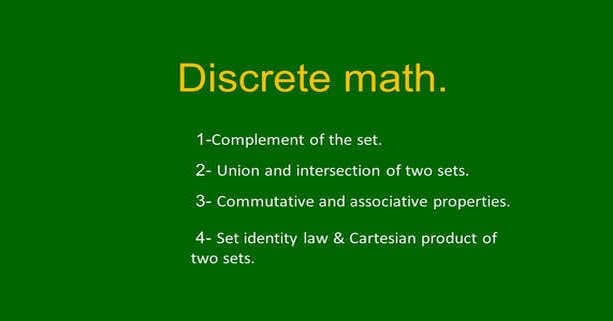- Complements Of A Set, Cumulative, Associative, Distributive Of Sets.
- The complement of a set.
- The union and intersection of a set.
- how to use the Venn diagram?
- Solved example#10.
- Cumulative, associative, and distributive properties of a set.
- Set identity law.
- Ordered pairs.
- Cartesian product of two sets.
- Another example for Cartesian Product Of Two Sets.
- N tuples.
- Definition of Vector space.
- Solved problem in R4.
Complements Of A Set, Cumulative, Associative, Distributive Of Sets.
The complement of a set.
This is a new example-if we have a universal set of U={1,2,3,4,5,6,7,8,9,10}, and the set A, which is another set, where A={1,2,3,4,5}, What is the new set which is called A’?A’ represents all the elements that exist in U but not present in set A. If we draw U as a rectangle and draw the set A inside that rectangle.
If we draw a circle around A, then A’ is called the complement of A. The complement of a set is the elements not present in set A, do exist in U.
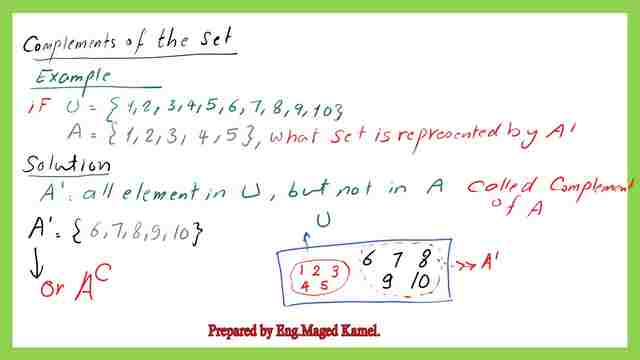

The union and intersection of a set.
The subject of union and intersection is a well-known subject. The intersection of two sets is the set of all elements that belong to both sets.
For a set which is called P={1,2,3,4,5,6,7,8,9,10}.
For another set which is called Q={2,4,6,8,9,10,12,14,16,18,20}.
The intersection of the two sets means the common elements of the two sets which are,2 and 4& 6& 8&10.
P ∩ Q, objects that belong to set P and set Q, the symbols are close to the letter n. While the union is similar to the letter U.
The definition of a union is the set of all elements that belong to either or both sets. We will write all the elements that are not repeated. P ∪ Q, will include1,2,3,4,5,6,7,8,9,10,12,14,16,18,20.


how to use the Venn diagram?
Using the Venn diagram, by drawing each set in a circle and examine the common elements for the intersection. This will enable us to do an investigation the relations in a form of a diagram.
Another example, if we have P={3,6,9,12,15,18} and Q={2,4,6,8,10,12}. If we use the highlighter for elements that are common between the two sets, the values are (6,12). This can be expressed as P ∩ Q, or the intersection of sets P and Q. if we draw the set p in a circle, it contains the elements of 3,6,9,12,15,18.
We draw the common elements (6,12) at the right edge. We draw the Q elements in another circle. What are the remaining elements of P, not included at the intersection?
The elements are 3,9,15,18. While the remaining elements from Q are (2,4,8,10). For another expression 6 is a part of the area enclosed by the intersection between P and Q. The enclosed area is showing 6 and 12.
Then it is a true statement that 6 belongs to the intersection of P and Q. But 8 does not belong to that intersection. It is written in this symbol 8 b∉P ∩ Q or the intersection of P and Q. While for the union relation for the universal set U, drawn as a rectangle.
Inside the rectangle, we can draw two circles for P and Q. All of the elements of both P and Q are thus included. The U will include U ={3,6,9,12,15,18,2,4,8,10}.


Solved example#10.
A new example. Let P= {3,9, 27}, Q={2,3,10,18,27,28}. R={2,10,28}. It is required the intersection between P and Q, or P∩ R & Q∩ R and P∩ R. What are the common elements between P and Q? These elements are (3,27). While between Q∩ R, these elements are (2, 28,10).
The total of three elements. While between P and R, there is none. Then we can express that intersection between P and R. P∩ R=Ø. or Ø. It is called a disjoint set, which means that these sets are not joined together.
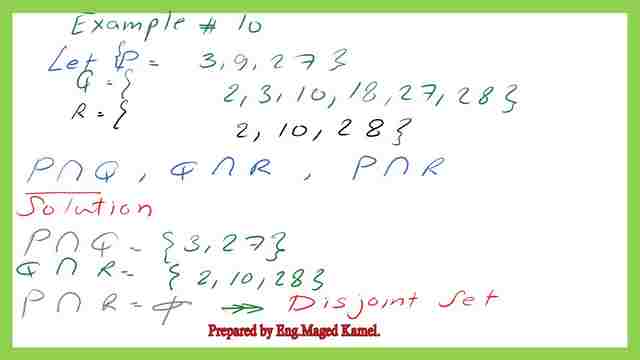

Cumulative, associative, and distributive properties of a set.
A new subject is the commutative, associative, and distributive properties of the set. The commutative relation can be expressed as A∩ B= B∩A.
Also A ∪ B=B ∪ A. The order can be reversed between A and B Can be reversed. but keep in mind that both the left-hand side and the right-hand side are intersections and for the second case both are unions. While for the Associative relation if we have three sets of A&B&C, it is required to make a union between these sets. This can be written as A ∪ (B ∪ C) = (A ∪ B)∪ C. A ∩ (B ∩ C)= (A ∩ B) ∩C.
The distributive property is the mix. The mix between union and intersection. It is called distributive A ∪ (B ∩ C)=(A ∪ B) ∩ C. Another relation is A ∩( B ∪ C)=(A ∩ B )∪C. We have discussed the cumulative, followed by the associative and the distributive.
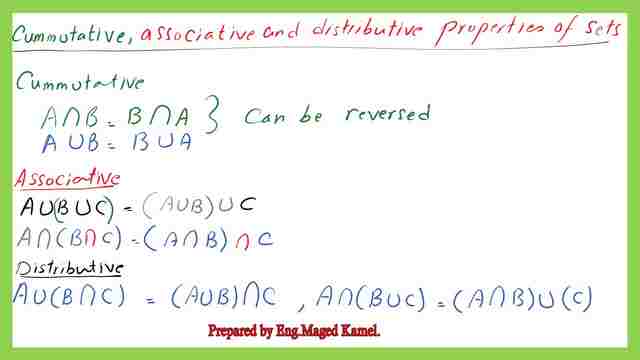

Set identity law.
There is a new item which is the set Identity Law. The first relation is A ∪A=A. The second relation is A ∩A=A. The third relation is A∪Ø =A. This is a true statement. While A ∩Ø=Ø. the subject of Power set if we have set A = A ={1,2,3,4}. What is the subset?
There is plenty of combinations of subsets as follows:
The first four numbers are selected, from 1 to 4., And then select {1,2}& {1,3} {1,4} and also select {1},{2},{3},{4}, then & select the same set order {1,2,3,4}, {1,2}& {1,3}&, (1,4}, other collection {1,2,3} {1,3,4}, How many selections so far, we have a total of 10 selections.
Starting with numbers 2, {2,3},{2,4}. Starting with the number 3, {3,4}, then select Ø. The total number of selections =5+5+6=16. In the end, if we have a set.
The total number of subsets that can be created = a number of elements raised to the power of 2 or 4×4=16.Make as power 2, that is why the expression of power set is used, since 4^2=16. If one set has three elements for instance, then the number of subsets=3^2=9.
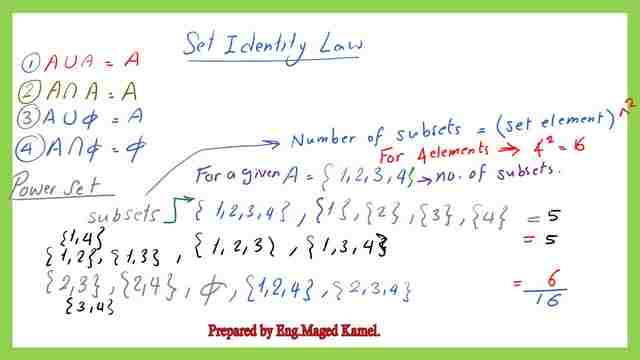

Ordered pairs.
The new item is the ordered pair, for the Cartesian coordinates x and y, we draw the x-axis first and then draw the y-axis. If we have a point A with a coordinate(5,2). The ordered pair is the sequence of the axes arrangement we go to the right 5 spaces, then come up 2 spaces. Here the sequence is important.
This is called ordered pair. Pair means two. If we select (5,2), it will give another point not point A. Set A, with elements {a,b}, and set B, with elements {c, d} will be considered equal if a=c and b=d.


The ordered pair can be used to solve equations, for the given example. For a given (x-3,y-2), given=set {4,5}. It is required to find the x,y values. Since both sides are equal, then x-3=4 and y-2=5.
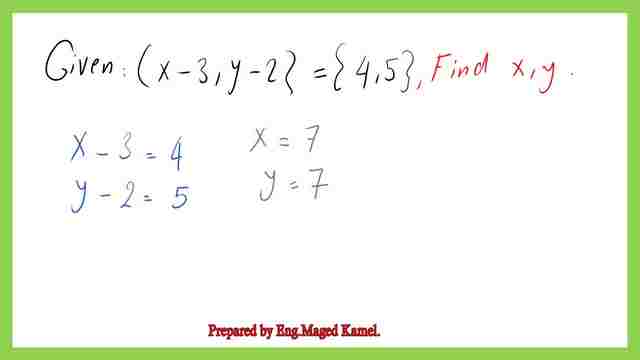

Cartesian product of two sets.
The Cartesian product of two sets. If we multiply two sets by each other it will be written as A cross B.
A new pair is constructed with x,y coordinates, such that x is a part of A and y is a part of B. As an example, if set A is ordered pair{7,8}, while set B is another the coordinates are {2,4,6}. It is required to find AxB. Following the order of operations, we can write,(7,2),(7,4),(7,6)& (8,2),(8,4),(8,6). It is the result of AXB. In the end, we have 6 ordered pairs.
Set A is composed of two elements. Set B is composed of three elements. Then AXB=2×3=6.
The ordered pair is the sequence of the axes arrangement we go to the right 5 spaces, then come up 2 spaces. Here the sequence is important.
This is called ordered pair. Pair means two. If we select (5,2), it will give another point not point A. Set A, with elements {a,b}, and set B, with elements {c, d} will be considered equal if a=c and b=d.
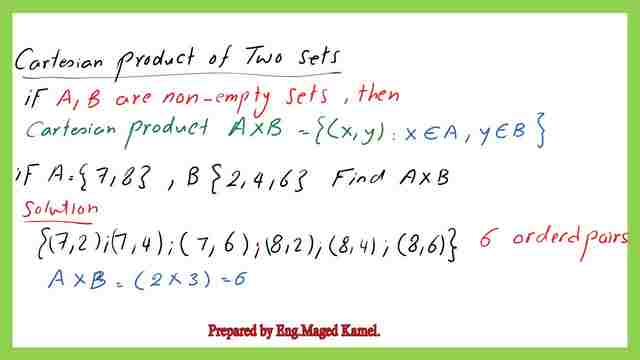

We can use a table to do the cross product of AxB, by setting the element of A in the first column, while writing the elements of b as the second, third, and fourth columns, in our example, there are three elements for set B.
Starting with 2, the first subset will be 2 with the second column value of b, then the same 2, will be with the third column of b and finally 2 will be with the last column of b element. Move to the second row, in which we have 3, then combine with 2, again with 4, and at last 2 will be combined with 6. The final answer is shown in the next slide image..
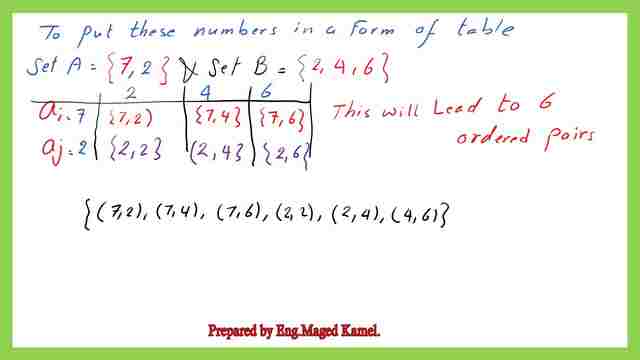

Another example for Cartesian Product Of Two Sets.
In another example, part of the ordered part is given and it is required to get A x B in terms of the given ordered pair, three subsets. If A and B are two sets. The AxB consists of 6 elements, which means that one of the sets is of 3 elements, while the other is from two elements. since 2×3=6.
Given only three elements of the product of AxB. it is required to get the full elements of AxB and AxA. From the given elements we call these elements as (a1,b1) ,(a2,b2) and (a3,b3).
The first three terms are a’s terms, so the set A can be written as A={2,3,4}. Then the b should be of two elements only, since AxB=6, these elements can be written as B={5,7}, b can not be three elements, 7 is repeated. AxB ={(2,5)(2,7), (3,5)(3,7), (4,3),(4,7) }, each ordered pair is different from the other pairs.
For the AxA={(2,2)(2,3), 2,4), (3,2)(3,3),( 3,4),(4,2)(4,3),( 4,4) }.


Again the use of a table to facilitate the estimation of the cross product of AxB.
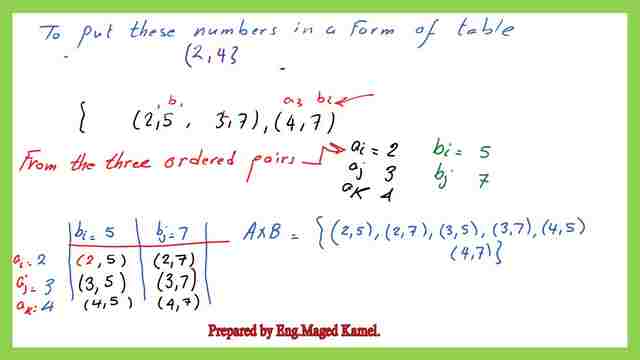

Use of table to facilitate the estimation of the cross product of AxA.
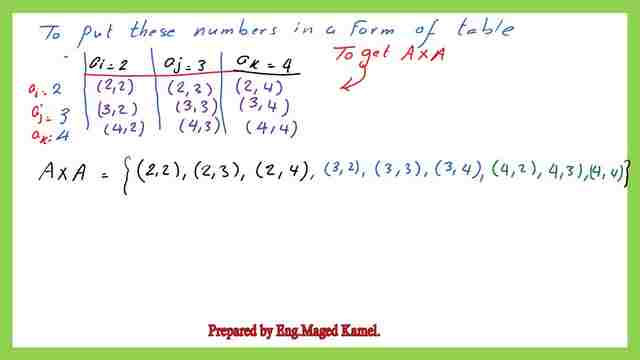

N tuples.
N-tuples, when we have three coordinates x,y,z. We want to show a point in space, so we need three coordinates.
For the point in space, with the coordinate(a1,a2a3), will follow the order in which we start with a1 in the x-axis direction, then the distance used is a2 in the direction of y, and finally a3 in the z-direction.3 tuples. This can be represented by a vector from the origin pointing to the point.
R3 is a linear algebra subject. Rn is in the n space. R3 is the set of all ordered triples of real numbers. R1 is a vector in the x-direction that can be also defined as the set of all real numbers in the 1-space.
R2 is a vector in the 2 space (x&y), written as a square of R.
The definition of it is the set of all ordered pairs, the definition is a bit different from the first definition of R1, which is a set of all real numbers.
R2 could be positive or negative numbers, R2 can be represented by plenty of choices, and the vector will be in the (x,y) direction. R3 is shown in the next slide. A new term which is R4 is presented.
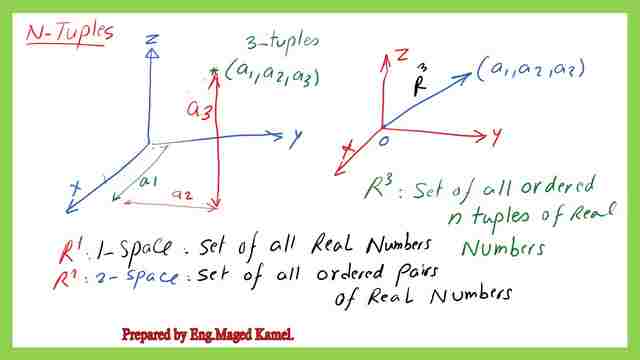

The next image shows a definition of vectors in Rn quoted from Prof. Ron Larson’s handbook.
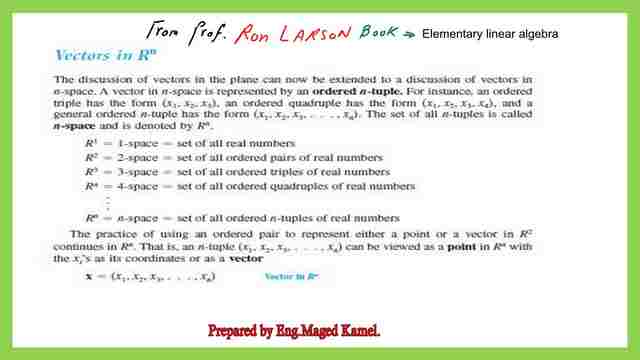

Definition of Vector space.
The definition of R4 is a set of all ordered quadruples of real numbers. Numbers, the point in R4 can be written as (a1, a2, a3, a4).
For Rn or vector in space, the point can be represented by (a1,a2,a3,….., an), and is called n-tuples. For the quadruples R4, the number of operations that can be performed in 10 operations, as we are going to see from the book of elementary linear algebra.
The first operation is closure under addition, the second operation is the commutative property u+v=v+u, and the third operation is u(v+w)=u+(v+w), U+Ø=U, additive identity. U+(-U)=0, additive inverse. Cu is in V, where c is a constant. C(u+v)=Cu+Cv, as distributive property. (C+d)U=cu+du. Distributive property, C(du)=Cdu.1*(u)=u. These are the operations.
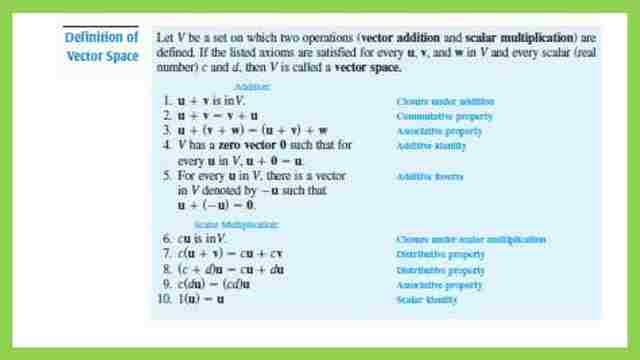

Solved problem in R4.
Our example for R4.The details of the points are given, and we will make the operation U+v+w, which will give (0,4,6,2).
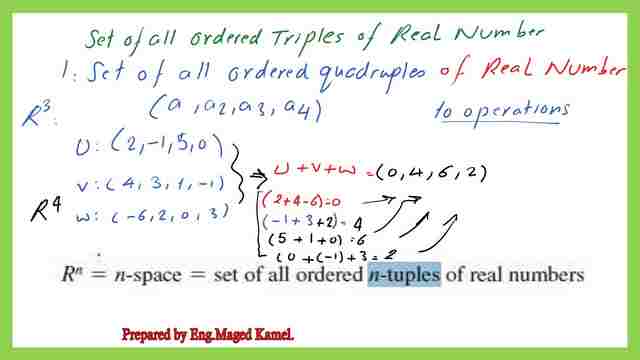

For an external link, please find this link. The story of mathematics.

